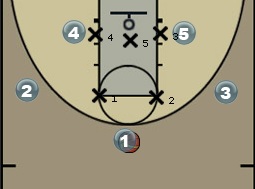Effective but Simple Youth Basketball Zone Defensive Tips & Techniques
Basketball Defense
In my opinion, defense is almost a dying art on the basketball court. It seems the higher level of play you achieve, the less teams emphasize team and individual defense.
That is why the few coaches at the professional level that do play defensive oriented ball are a COMMODITY.
I believe it is important to develop a complete skill set especially in youth players when learning how to play defense.
Therefore, initially you should probably AVOID a zone defense and teach individual guarding skills and techniques through man-to-man defense to allow young players to fully develop their entire game. Plus, they will always have a chance to play and learn different zone defensive strategies!
As you advance into high school and college ball it will become more necessary to be able to utilize a zone defense properly on various occasions. At times, if you play or coach at the professional level you will have no choice but to employ a zone defense.
When to Use a Zone Defense
If your opponent has a decent youth basketball coach and a few skilled players, you may have to utilize a zone defense as your best chance to defend them.
The zone defense will assign an area to each defensive player rather than a man.
In order for the zone defense to work properly each defensive player must hustle at all times to beat their opponents to the other end of the floor.
At the youth level, if your opponent has a few skilled guards, the zone defense can slow the pace of the game slightly helping limit the number of overall EASY shots taken in a game.
If you have a bigger, slower team the zone defense allows you to put your “Bigs” around the basket while your “Smalls” stay out on the perimeter.
This makes it harder for your opponents to get quality shots and your team to hopefully get more rebounds, unless you allow your opponents to beat you on the dribble and penetrate your “Bigs”.
A classic example of when to use a zone defense can probably be best demonstrated when the Dallas Mavericks played the Miami Heat in the NBA Finals.
You had the “Heat” with multiple superstars and an older, more mature, OK (aging) “Maverick” team that was predicted to struggle to stay with the much faster, younger players of the “Heat”.
This would be a case for an ideal situation to use the zone defense. Unfortunately, in this scenario Lebron James didn’t find his perimeter jump shot and the entire team struggled, which resulted in a NBA Finals loss for the Miami Heat.
Nevertheless, sometimes the BEST answer is to slow the game down to a pace your team is more comfortable with.
Zoned Out

It is true that the zone defense may not be as flashy as a man-to-man defense and slows the pace of the game, preventing some of the one-on-one slam dunks that you may see from Kobe or Lebron.
But if it gives your team the best chance to win at the end of the day in youth sports then that’s what counts for the most part.
I will say, I’m not ALL about promoting winning at the youth level, winning is fun and it keeps kids happy and provides a sense of accomplishment.
However, as I mentioned in the beginning developing kids skills and techniques is the MOST important. If you can get that from man-to-man then great, if your team needs to zone it up, then do that as well, but teach them how to play defense, whether zone or man.
Zone defenses are effective if your team is small and the other team has big players that are pretty dominant.



LEAVE A COMMENT